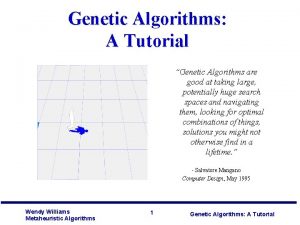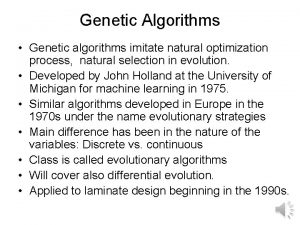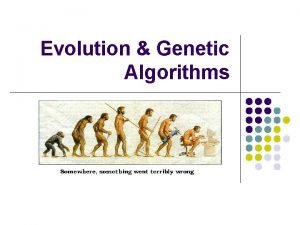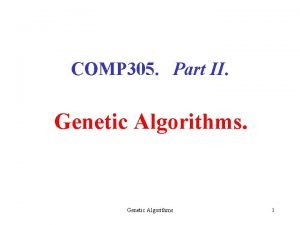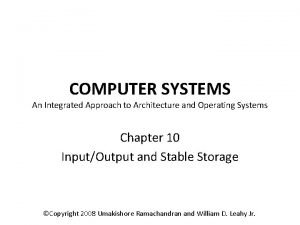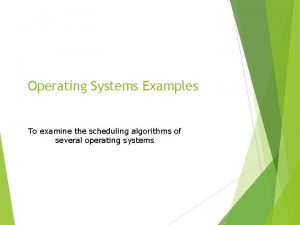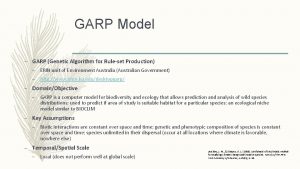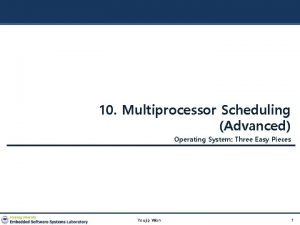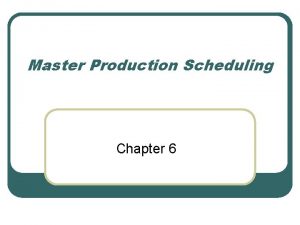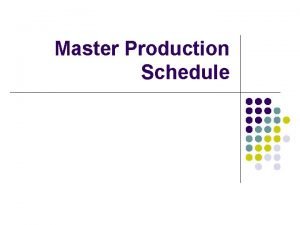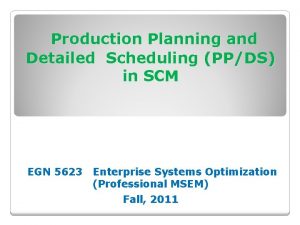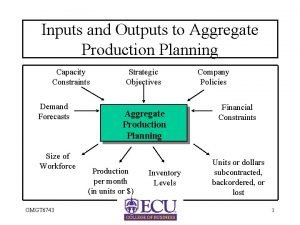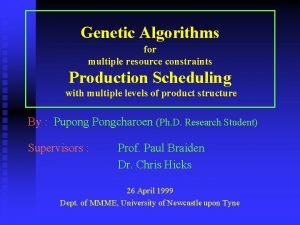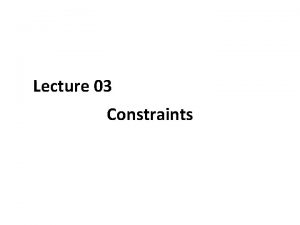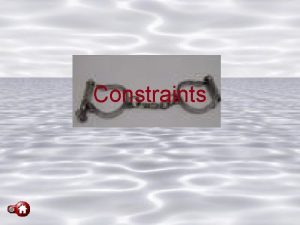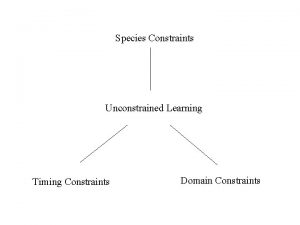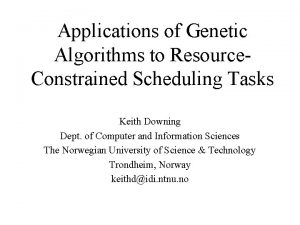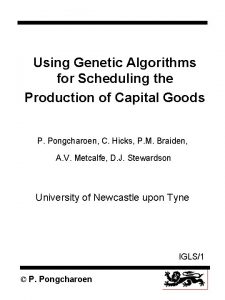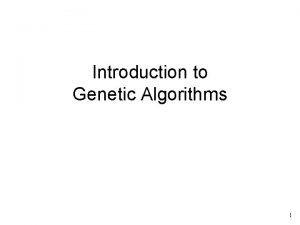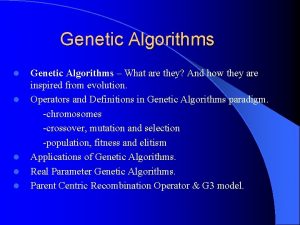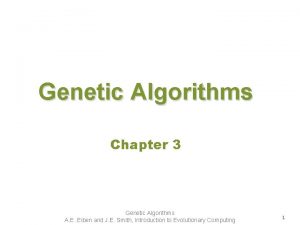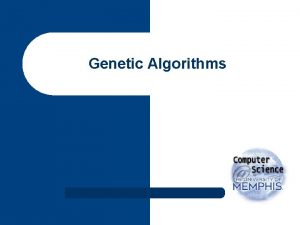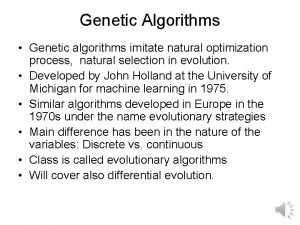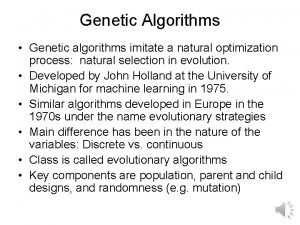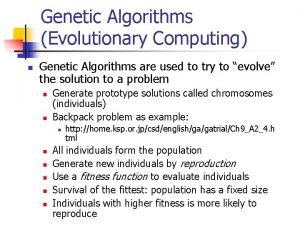Genetic Algorithms for multiple resource constraints Production Scheduling



























- Slides: 27

Genetic Algorithms for multiple resource constraints Production Scheduling with multiple levels of product structure By : Pupong Pongcharoen (Ph. D. Research Student) Supervisors : Prof. Paul Braiden Dr. Chris Hicks 26 April 1999 Dept. of MMME, University of Newcastle upon Tyne

Overview of this presentation ò ò ò ò Background and literature review Characteristics of production scheduling problem Optimisation algorithms Genetic Algorithms(GAs) applied to production scheduling Experimental Program Results Discussions and conclusions

What is scheduling ? “ The allocation of resources over time to perform a collection of tasks ” Baker(1974) “ Scheduling problems in their simple static and deterministic forms are extremely simple to describe and formulate but difficult to solve ” King and Spackis(1980)

Scheduling problems n jobs & m machines = (n!)m possible solutions e. g. 20 x 10 problem => 7. 2651 x 10183 solutions

Type of scheduling problems in literature ò Job shop problem (JSP) different routing of jobs Þ machines ò Flow shop problem (FSP) same routing of jobs Þ machines ò Permutation scheduling problem (PSP) same job sequence Þ machines King and Spackis (1980)

Literature review

Optimisation algorithms n Conventional optimisation algorithms Example Branch & Bound, Integer Linear Programming and Dynamic Programming. n ò works well with small problems slow can’t solve “big” problems ò ò ò Approximation optimisation algorithms Example Dispatching rules, Simulated Annealing, Taboo Search and Genetic Algorithms. fast can be applied with big or small problems approximate “optimal” solutions. Jain et. al. (1999)

Product structure from company

Type of scheduling environment ò Machine environment Þ Single or Multiple machines ò Product environment Þ Single or Multiple products ò Capacity planning Þ Infinite or Finite resources constraints ò Research methodology Þ Analytical or Simulation methodology

The objectives of this research ò Apply Genetic Algorithms to complex capital goods production scheduling problems ò Minimising penalty cost due to earliness and tardiness ò Assume finite capacity ò Using simulation methodology for testing plans

Production Scheduling with multiple levels of product structure

Example of Gantt Chart

Fitness function Minimise : Where å Pe(Ec+Ep) + å Pt(Tp) Ec = max (0, Dc - Fc) Ep = man (0, Dp - Fp) Tp = max (0, Fp - Dp)

Genetic Algorithms

Crossover Operation

Mutation Operation

Demonstration of Genetic Algorithm Program ò Genetic Algorithms for scheduling problems was written by using Tcl/Tk programming language. ò The program was runs on Unix system V release 4. 0 on a Sun workstation.

Case study (data from Parsons)

Experimental program Full factorial experimental design was performed. Total number of runs = 3 x 2 x 4 x 5 = 240 (per replication)

Results from 240 runs on each problem sizes

Analysis of Variance

The best performance of GAs on the problems

Mean and standard deviation for each population

Discussions ò When the problem size increases the execution times increase exponentially. ò Next step is to break “large” problems down into smaller independent problems that can be solved in a “reasonable” amount of time. ò The solutions to the small problems will be integrated to give an overall solution.

Conclusions ò Genetic algorithms represents a powerful technique for solving scheduling problems. ò Practical software produced for solving scheduling problems. ò Solutions far better than original schedules obtained from Company ò Appropriate levels for Genetic Algorithm parameters identified.

Further Research ò Bicriteria ò Multiple scheduling problems. criteria scheduling problems.

Any questions please ?
 Membuat alur proses produksi multimedia
Membuat alur proses produksi multimedia Genetic algorithms tutorial
Genetic algorithms tutorial Genetic algorithms
Genetic algorithms Lamarckian evolution
Lamarckian evolution Dairy comp 305 tutorial
Dairy comp 305 tutorial Founder effect definition biology
Founder effect definition biology Genetic programming vs genetic algorithm
Genetic programming vs genetic algorithm Genetic programming vs genetic algorithm
Genetic programming vs genetic algorithm Genetic drift
Genetic drift Genetic drift vs genetic flow
Genetic drift vs genetic flow Disk scheduling algorithms
Disk scheduling algorithms Solaris dispatch table
Solaris dispatch table Job scheduling vs process scheduling
Job scheduling vs process scheduling Genetic algorithm for rule set production
Genetic algorithm for rule set production Resource-limited scheduling
Resource-limited scheduling Resource histogram
Resource histogram Cloud resource scheduling
Cloud resource scheduling What are the impacts of resource constrained scheduling
What are the impacts of resource constrained scheduling Scheduling time-constrained projects focuses on resource
Scheduling time-constrained projects focuses on resource Multiple processor scheduling in os
Multiple processor scheduling in os 1/8 script breakdown
1/8 script breakdown Inventory management and production planning and scheduling
Inventory management and production planning and scheduling Mps excel template
Mps excel template How to create a master production schedule
How to create a master production schedule Detailed scheduling
Detailed scheduling Production schedule example in business plan
Production schedule example in business plan Resource leveling is the approach to even out the peaks of
Resource leveling is the approach to even out the peaks of Perbedaan resource loading dan resource leveling
Perbedaan resource loading dan resource leveling

